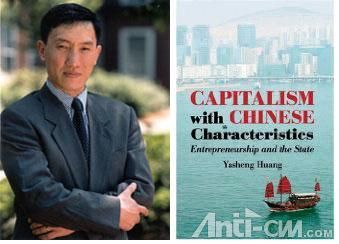【原文标题】What's wrong with Shanghai?(partII)
【登载媒体】theglobalist.com
【来源地址】http://www.theglobalist.com/StoryId.aspx?StoryId=7407
【译者】荡漾
【声明】本翻译供Anti-CNN使用,转载请注明译者及出处,谢谢!
【译文】
 尽管上海有很强的发明能力,但其稚嫩的创业文化意味着这座城市的专利对经济总量的影响微乎其微。在《有中国特色的资本主义》一书中(注:封面见左图),作者黄亚生(注:见左图)解释了上海表现出具备发明能力但缺乏创新能力这一典型苏联综合症的原因。
尽管上海有很强的发明能力,但其稚嫩的创业文化意味着这座城市的专利对经济总量的影响微乎其微。在《有中国特色的资本主义》一书中(注:封面见左图),作者黄亚生(注:见左图)解释了上海表现出具备发明能力但缺乏创新能力这一典型苏联综合症的原因。
与广东省及邻近的浙江省相比,上海在将发明转化为有益商业运用的创新行为上尤为薄弱。
在具备发明能力和创新能力二者之间有一个重要的区别:发明所需要的能力与其潜在的市场价值无关;创新则是受到一种市场价值实现激励的能力。
如前苏联那种自上而下组织严密的综合官僚政治体制由于政府在科技上的巨额投入而具备了很强的发明能力。
问题是前苏联经济在新科技及其发展上不具备创新能力,原因在于未能将科技上的重大成果转化为有益的商业运用。庞大的R&D支出对经济整体影响却微乎其微。
上海表现出典型的苏联综合症——具备发明能力,但缺乏创新。2005年上海的大学、研究所及政府机构获批1895项专利。这一数字比起浙江的841项及广东的644项可观得多,但事实上浙江及广东两省的专利总数量都要比上海多。
原因在于这些都来自非赢利机构,这些发明活动与其市场价值无关。上海在更具市场目的性的专利类别中表现欠佳。
2005年上海公司专利有8486项,而广东的公司专利数达到11518项(浙江省以3892项大大少于上海)。
但上海与这两个省份之间最大的不同在于个人专利持有者的数量。2005年上海只有2222个私人专利持有者,与浙江(14333)和广东(24732)甚至都不在一个水平上。
上海有一点与前苏联不同甚而优于它——上海开放外商直接投资(FDI)。因此问题不在于企业家是否对城市产生影响,而在于没有本土企业家是否产生影响。
答案仍然是肯定的,不过原因有点复杂。上海模式的本质是限制上海居民发展成资本家的机会,而为外国资本家创造一个有效且具有吸引力的平台进行投资建设。
这就解释了家庭调查数据中所显示普通上海家庭资产规模之小的原因。比起本土企业家,跨国公司能提供高得多工资的事实在一定程度上补偿了低水平的创业收入。
又与之一致的是家庭调查数据显示平均上海居民拥有国内最高的工资水平。平均来看上海人在国内属于最为富有的无产阶级,不过同时归入国内最穷资本家的行列。
因此有人将其视作一种调节——较低的赢利性收入由较高的流动性工资收入来补偿。
若是出现某种外部冲击,上海模式将会反过来困扰上海。外部冲击的形式可能是印度崛起成为吸引外商直接投资点;也可能是国内其他地区崛起而具备与上海竞争的实力。本地企业有种本土偏爱更愿意在大本营运作。
上海模式最为不利之处在于损害了本地企业吸引顶尖人才的能力。
本地企业在人才市场能与资本雄厚的跨国公司竞争为数不多的方法之一在于它们能够提供更大的未来回报:股权或是通往法人合伙人的最高层次的职业生涯。
这基本上就是像Infosys及Wipro这样的印度企业有能力与IBM及GE竞争而招募并留住国内最具工程技术人才的方法。
对本地企业家上升势头的压制限制了本地企业家用以吸引人才的上限价值。
一旦市场认为这些本地企业无法发展壮大,那么它们除了在提供流动性回报基础上进行竞争之外将别无选择。
跨国公司掌握了在流动性回报基础上竞争的一种决定性优势。更多人才涌向这些公司则又增强了其政策优势,进而更进一步巩固其市场垄断地位。
注:请同时关注上海怎么了?(一)
【原文】
Although Shanghai has a high capacity for invention, its nascent culture of entrepreneurship means that the city's patents have little effect on the city’s overall economy. In this Globalist Bookshelf selection from "Capitalism with Chinese Characteristics," Yasheng Huang explains why Shanghai exhibits the classic Soviet syndrome of being inventive but not innovative.
Shanghai is particularly poor in innovative activities that convert inventions into useful commercial applications, as compared with the neighboring entrepreneurial areas of Zhejiang and Guangdong.
There is an important distinction between being inventive and being innovative: Inventions are acquisitions of capabilities without reference to their underlying market value. Innovations are acquisitions that are motivated by a realization of market values.
A top-down bureaucratic system, such as that in the former Soviet Union, can be quite inventive because of massive investments in science and technology by the government.
The problem is that the Soviet economy was not innovative in new technologies and processes — because it failed to convert the scientific breakthroughs into useful commercial applications. The massive R&D expenditures had very little effect on the economy as a whole.
Shanghai exhibits the classic Soviet syndrome — it is inventive, but not innovative. In 2005, universities, research institutes and government agencies in Shanghai were granted 1,895 patents. This is substantially more than in Zhejiang (841) and Guangdong (644), despite the fact that Zhejiang and Guangdong both had larger total patent counts.
Because these are non-profit institutions, these are inventive activities without reference to their market value. Shanghai under-performed in the more market-oriented patenting categories.
In 2005, there were 8,486 patents granted to firms in Shanghai — but there were 11,518 granted to firms in Guangdong. (Zhejiang had far fewer than Shanghai, at 3,892.)
The greatest difference between Shanghai and these two other provinces lies in the number of individual patent grantees. In 2005, Shanghai had only 2,222 individual patent grantees. This does not even begin to compare with Zhejiang (14,333) or Guangdong (24,732).
In one respect, Shanghai is fundamentally different from — and superior to — the former Soviet Union: Shanghai is open to foreign direct investment (FDI). So, the question is not whether it matters to have entrepreneurs — but whether it matters not to have indigenous entrepreneurs.
The answer is still yes, although the reasoning is a bit more complicated. The essence of the Shanghai model is to restrict the opportunities for Shanghai residents to become capitalists — but to create an efficient and attractive platform for foreign capitalists to set up production facilities.
This explains the paucity of asset returns to the average Shanghai households in household survey data. The low entrepreneurial income is partially compensated for by the fact that multinational companies can offer a substantially higher level of wages than the majority of indigenous entrepreneurs.
This again is consistent with household survey data that show the average Shanghai resident to have the highest wage level in the country. The average Shanghainese are the richest proletariat in the country — but among the poorest capitalists in the country.
So, one can argue that it is a wash — that lower profit incomes are made up for by higher current wage incomes.
The Shanghai model will come back to haunt Shanghai if there is an external shock. One form of such an external shock might be the rise of India as an attractive FDI location, or the rise of other regions in China that can compete with Shanghai. Local firms have a home bias in that they have a preference to operate in their home base.
The most detrimental aspect of the Shanghai model is that it has damaged the ability of local firms to attract top human talent.
One of the few ways that local entrepreneurial businesses can successfully compete with the deep-pocketed multinational companies in the talent market is that they can offer greater future payoffs — stock options or career paths to the top of the corporate hierarchy.
This is basically how Indian firms, such as Infosys and Wipro, were able to compete with IBM and GE to recruit and retain the best engineering talent in the country.
Suppressing the growth potentials of local entrepreneurs caps the value of the upside option these local entrepreneurs can offer to attract human talent.
If the perception in the market is that these local businesses cannot grow big, then these local firms will have no choice but to compete on the basis of offering current payoffs.
Multinational companies command a decisive advantage in competition on the basis of current payoffs. Greater talent flows to these corporations reinforces their policy advantages — and further solidify their market dominance.
【截图】

|